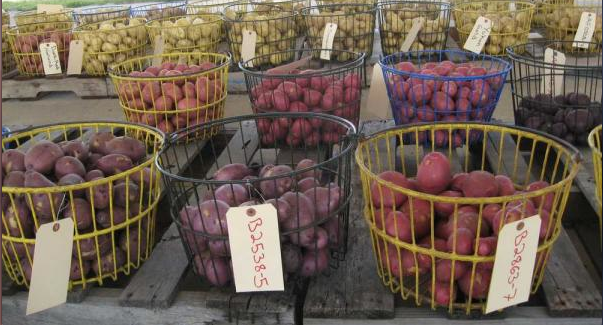The time to plant potatoes is now!
Potatoes are a good way to usher in the growing season of your home garden. They are easy to grow and their harvesting date doesn’t coincide with many other vegetables. In North Florida you can plan to put in your potatoes around the end of January through February. It’s easy to grow red- and white-skinned Irish potatoes. Also, brown-skinned russet potatoes do nicely in the garden. However, before we get ahead of ourselves, the first step you need to take is preparing your soil and garden plot.
Since potatoes prefer a loose, well-drained, slightly acidic soil (pH 5 to 6), little needs to be done in many Florida gardens. However, potatoes do not grow well in flooded conditions. Care must be taken to ensure that the root zone has adequate drainage. To help alleviate flooding conditions, beds should be formed into mounds (hills) about 10 to 12” above soil level. It’s always a good idea to add in organic matter to your soil, this will provide nutrients and structure to your soil.
The potato tuber is the plant “part” required to grow a new potato plant. When a piece of the tuber is planted, it is called a “seed” potato. Only certified seed potatoes should be planted in the home garden. Certification ensures that the seed tubers are free of disease and viruses. Certified seed can be obtained from a number of reputable garden supply stores. Do not purchase potatoes from the grocery store to plant in the home garden. Potatoes from grocery stores are often sprayed with chemicals that inhibit sprouting and they can contain diseases that would be harmful to your garden. Also, remember to never store tubers in direct sunlight. Seed potatoes should be cut so that each piece is about the size of an egg with at least one eye per seed piece. Seed potatoes should be allowed to “heal” before planting; this will reduce the risk of rot upon planting.
Potato plants should be spaced at about 6–8 in. within the row with at least 36 in. between rows. Seed pieces should be planted with the cut side down and eyes (or sprouts) facing up. Due to the fact that the seed piece should be planted only 4 in. below soil surface, new tubers could emerge from the soil surface. These exposed tubers will turn green and inedible in the sun. Therefore, hilling is a necessary process in growing potatoes. Hilling is the act of adding about 2 – 3 in. of soil to the top of the potato row.
Potatoes, in Florida are generally grown during the drier times of the year. As a result, supplemental irrigation may be required to provide plants with an adequate amount of water. Moderate soil moisture levels should be maintained throughout the season. Just remember to never over water!
Most potatoes are ready for harvest between 80 and 115 days after planting. To harvest, carefully dig potatoes below the potatoes and remove them from the root system of the plant. Potatoes are best stored in cool, dark, well-ventilated locations. An important fact to remember when harvesting potatoes is to always avoid eating green potatoes. Green potatoes have high levels of a toxin called solanine, which has a bitter taste. It is toxic even at very low levels. Potatoes can “green” in the field, in storage, and at home when exposed to the light.
As always, if you have any question or need further information please contact your local extension agent!
- Reference Books for Gardeners and Landscapers Alike - August 3, 2015
- The Danger Within… What’s Hiding in Our Woods - June 15, 2015
- What To Do with All This Rain? Plant a Rain Garden! - April 14, 2015

